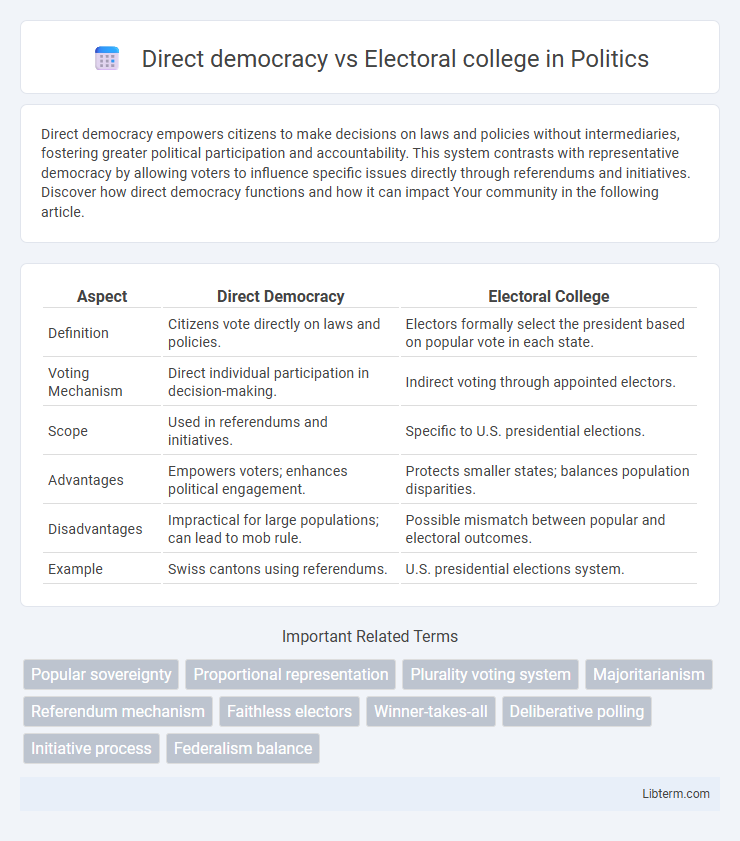Direct democracy empowers citizens to make decisions on laws and policies without intermediaries, fostering greater political participation and accountability. This system contrasts with representative democracy by allowing voters to influence specific issues directly through referendums and initiatives. Discover how direct democracy functions and how it can impact Your community in the following article.
Table of Comparison
| Aspect | Direct Democracy | Electoral College |
|---|---|---|
| Definition | Citizens vote directly on laws and policies. | Electors formally select the president based on popular vote in each state. |
| Voting Mechanism | Direct individual participation in decision-making. | Indirect voting through appointed electors. |
| Scope | Used in referendums and initiatives. | Specific to U.S. presidential elections. |
| Advantages | Empowers voters; enhances political engagement. | Protects smaller states; balances population disparities. |
| Disadvantages | Impractical for large populations; can lead to mob rule. | Possible mismatch between popular and electoral outcomes. |
| Example | Swiss cantons using referendums. | U.S. presidential elections system. |
Introduction to Direct Democracy and the Electoral College
Direct democracy allows citizens to vote directly on laws and policies without intermediary representatives, embodying pure popular sovereignty. The Electoral College is an indirect voting system where electors, rather than the general populace, formally select the President of the United States. These systems contrast in how democratic participation and decision-making authority are structured, affecting voter influence and political representation.
Historical Origins: How Each System Emerged
Direct democracy originated in ancient Athens around the 5th century BCE, where citizens participated directly in decision-making processes through assemblies and voting on laws. The Electoral College was established in the late 18th century during the drafting of the United States Constitution as a compromise between election of the president by Congress and direct popular vote, aiming to balance power among states. Both systems reflect distinct historical contexts: direct democracy in early city-states emphasizing citizen involvement, and the Electoral College emerging from federalist concerns over representation and federal balance.
Core Principles and Mechanisms
Direct democracy centers on citizen participation where individuals vote on laws and policies without intermediaries, emphasizing majority rule and direct accountability. The Electoral College operates as an indirect system in U.S. presidential elections, allocating votes based on state populations to balance influence between populous and smaller states. Core mechanisms contrast as direct democracy relies on popular vote outcomes, while the Electoral College incorporates a state-based electoral voting process, often leading to results differing from the national popular vote.
Advantages of Direct Democracy
Direct democracy empowers citizens by allowing them to vote on laws and policies directly, ensuring greater public participation and accountability in governance. It reduces the risk of elite manipulation present in systems like the Electoral College, which can sometimes distort the popular vote in presidential elections. This form of democracy fosters transparency and can lead to decisions that better reflect the immediate will of the majority.
Strengths of the Electoral College System
The Electoral College system enhances federalism by balancing power between populous and smaller states, ensuring regional interests are represented in presidential elections. It provides a clear and decisive outcome, often avoiding prolonged vote counts and minimizing the risk of contested results. This system encourages presidential candidates to campaign nationwide, promoting broader national engagement rather than focusing solely on densely populated urban centers.
Challenges and Criticisms of Direct Democracy
Direct democracy faces challenges such as the potential for majority tyranny, where the rights of minority groups may be overlooked without adequate protections. It often struggles with practical implementation issues, including low voter participation and the complexity of policy matters that may exceed the average citizen's expertise. Critics also highlight the risk of misinformation influencing public decisions and the inefficiency of frequent referenda in large, diverse populations.
Controversies Surrounding the Electoral College
The Electoral College faces controversies due to its potential to elect a president who does not win the popular vote, as seen in the 2000 and 2016 U.S. presidential elections. Critics argue this system disproportionately amplifies the influence of smaller states while marginalizing populous urban areas, resulting in unequal voter representation. Disputes also arise from "faithless electors," who may vote contrary to their state's popular outcome, challenging the system's democratic integrity.
Impact on Voter Representation and Fairness
Direct democracy enhances voter representation by allowing citizens to vote directly on policies, ensuring that public opinion shapes legislative outcomes without intermediary distortion. In contrast, the Electoral College can skew fairness by enabling a minority of voters in key states to disproportionately influence presidential elections, potentially marginalizing wider popular preferences. This system often diminishes the principle of "one person, one vote," impacting equitable voter representation across diverse regions.
Modern Examples and Case Studies
Switzerland's direct democracy exemplifies citizen participation through frequent referendums and initiatives impacting policy decisions nationwide. In contrast, the United States employs the Electoral College system, where presidential election outcomes are determined by state-level electors rather than direct popular vote, influencing campaign strategies and representation. Studies of the 2000 and 2016 U.S. elections highlight disparities between popular vote and electoral outcomes, fueling debates on democratic legitimacy.
Future Prospects: Reform or Maintain?
Future prospects for the Electoral College involve debates over reform to enhance democratic representation or maintain its current role in balancing state interests. Proposals such as the National Popular Vote Interstate Compact aim to align electoral outcomes more closely with the popular vote, potentially diminishing the Electoral College's traditional influence. Conversely, advocates for preservation emphasize its role in protecting smaller states' political power and preventing regional dominance in presidential elections.
Direct democracy Infographic

 libterm.com
libterm.com